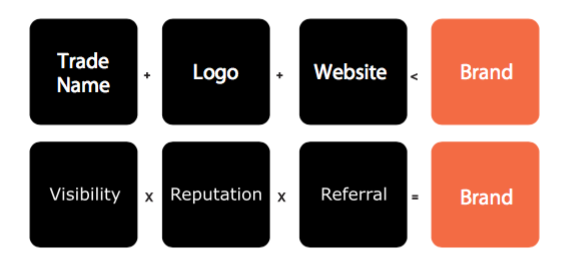The Power of Branding: Everything You Need to Know"


To clear up some common misconceptions about branding:
Firstly, a brand is not simply a logo or visual representation.
Secondly, the brand name alone does not encompass the entire brand.
And thirdly, a brand is not just a product or service.
So what exactly is a brand?
A brand is the sum of impressions and associations that a customer accumulates in their mind over time, through interactions with various touchpoints such as logos, ads, products or services.
A brand is a promise that exists in the customer’s mind, a pledge of quality and consistency.
A brand is an intangible sensation that customers immediately recognize when encountering a product or company.
A brand is a distinct idea, concept, or term that occupies a unique space in the customer’s mind, fostering emotional connections and loyalty.
Ultimately, a brand is a lifelong relationship between a business and its customers, built upon trust, consistency, and shared values.
The power of a brand lies in its ability to influence consumer behaviour and create customer loyalty. A strong brand can:
- Increase recognition and awareness: A well-established brand is easily recognizable and memorable, making it easier for customers to identify and choose the brand over competitors.
- Build trust and credibility: A strong brand conveys a sense of reliability, quality, and consistency, which can lead to increased customer trust and loyalty.
- Create emotional connections: A brand that evokes positive emotions can establish a deeper connection with customers, fostering a sense of belonging and loyalty.
- Command premium pricing: A strong brand can justify higher prices based on the perceived value and quality associated with the brand.
- Drive customer referrals and word-of-mouth marketing: Customers who have positive experiences with a brand are more likely to recommend it to others, creating a valuable source of organic marketing.
Overall, the power of a brand is its ability to differentiate itself from competitors and create a lasting impression on customers, leading to increased sales and brand equity.
Branding brings a multitude of benefits:
Firstly, a strong brand is a company’s most valuable asset, serving as a foundation for its reputation and success.
Secondly, a well-established brand can translate into significant profits for a company, as customers are more likely to choose a trusted and recognizable brand over its competitors.
Thirdly, a strong brand can significantly increase a company’s overall value and assets, making it a more attractive investment opportunity.
And fourthly, by establishing a clear and consistent brand identity, a company can reduce costs associated with marketing, advertising, and customer acquisition, as customers are naturally drawn to a brand that is easily recognizable and trustworthy.
In summary, investing in branding can lead to increased profitability, improved brand value, and reduced costs, making it a wise decision for any company looking to establish a strong and lasting presence in the market.
A branding agency plays a crucial role in today’s market for several reasons:
Firstly, consumers have numerous options to choose from and limited time to make a purchasing decision.
Secondly, many products and services offer similar quality and features, making it difficult for consumers to differentiate between them.
Thirdly, trust is a key factor in the buying decision, as consumers are more likely to choose a brand they trust over an unknown or unproven one.
Moreover, consumers tend to repeat they’re positive experiences with a product or service, leading to long-term customer loyalty and advocacy.
That’s where Absolute Creative, a leading branding agency, comes in with its Six Brand Essentials method. This comprehensive approach covers all aspects of a business, from A to Z, ensuring that the brand is well-positioned to stand out in a crowded market. With a focus on building trust, creating differentiation, and fostering customer loyalty, Absolute Creative’s method the 6 brand essentials has proven to be highly effective in creating successful and memorable brands.

“The Vital Role of a Branding Agency: Elevating Your Business to Success”
1. Research + Analysis
The first step in building a successful brand is conducting thorough research and analysis. This involves examining your core customers, competitors, and internal perceptions, values, and competencies. It’s important to note that a company’s self-perception may not always align with its customers’ needs and expectations.
To accomplish this, a combination of existing data and new research is typically employed. By carefully reviewing and analyzing this information, a brand can gain valuable insights into the marketplace and better understand how to position itself for success.
To bridge the gap between a company and its customers, it’s important to take several key steps:
Firstly, it’s essential to truly understand your customers to identify your core client base. By conducting thorough research and analysis, a brand can gain valuable insights into the needs, preferences, and behaviours of its target audience.
Secondly, it’s important to take a close look at your competitors and assess how they are performing in the marketplace. This can help a brand identify gaps in the market and better position itself for success.
And thirdly, it’s crucial to have a deep understanding of your own company and what it does well. This involves taking stock of your strengths, weaknesses, and unique selling points to create a clear and compelling brand identity that resonates with customers.
By taking these steps and focusing on building strong relationships with customers, a brand can successfully bridge the gap and establish a loyal and engaged customer base.
2.Positioning

After conducting research and analysis, the next crucial step in building a successful brand is developing a clear and concise market position.
Brand positioning should answer the question of how you differ from your competitors in a way that is relevant to your core customers.
To stand out in the crowded marketplace, your brand positioning should accomplish three key things:
- Be different – differentiate yourself from your competitors in a way that is unique and compelling to your target audience.
- Be focused – narrow your services or expertise to find a niche in the market that will attract customers and allow you to charge a premium price for your offerings.
- Be relevant – before committing to a specific niche, test the waters to determine if there is sufficient interest among your target audience.
By following these guidelines and focusing on creating a strong and differentiated brand positioning, a brand can establish a clear and compelling identity that resonates with customers and sets it apart from the competition.
3. Promise
A brand promise is a natural extension of a company’s positioning strategy. It represents the tangible benefits and outcomes that customers can expect to experience when engaging with the brand.
When crafting your brand’s promise, it’s important to focus on creating a benefit that generates a desire for your product or service. A brand promise is only effective if it’s done correctly and establishes an emotional connection with the target audience.

What promises is your brand making to its customers?
To effectively motivate customers, a brand promise must achieve three key goals:
- Convey a compelling benefit that resonates with the target audience.
- Be authentic and credible, establishing trust and a sense of reliability with customers.
- Consistently deliver on the brand promise to ensure that customers have a positive and consistent experience with the brand. This means that a company cannot change its brand promise without a fact-based decision to reposition the brand.
By focusing on these goals, a brand can create a promise that truly resonates with its customers, establishing a strong and lasting connection that leads to increased loyalty and engagement.
4. Creative
Our understanding of the world is heavily influenced by visual imagery, and the same is true for how we experience businesses. Images can set the tone, create expectations, and set a brand apart from its competitors.
To create a strong and consistent brand identity, visual imagery and messaging should align with your brand’s positioning and personality.

To achieve this, your creative strategy should focus on:
- Crafting a clear and compelling brand message that resonates with your target audience.
- Developing a strong brand personality that reflects your company’s values and unique identity.
- Presenting your brand visually in a way that is cohesive, memorable, and effectively communicates your message and personality.
5. Implementation
During the implementation phase, the brand strategy, marketing strategy, advertising strategy, and visual identity are brought to life through various media and channels.

The brand implementation process should encompass every aspect of the business and customer touchpoints, from public relations to trade shows and employee training, to ensure that the brand is consistently represented in all interactions.
By turning your brand positioning into concrete materials and experiences that resonate with your target market, you can effectively communicate your brand’s identity and values, establish a strong presence in the marketplace, and build lasting relationships with your customers.
Turn your positioning to concrete materials to reach your target market.
6. Ongoing operations
Once a company has rolled out a new or refreshed brand, the ongoing operations stage begins. During this phase, it’s important to monitor the brand’s impact on lead generation, conversions, referrals, recruiting, customer satisfaction, product quality, growth, and profitability. This enables the company to make adjustments and fine-tune its branding strategy as needed.

While a company can technically survive without branding, it’s ultimately about thriving and creating a lasting emotional connection with customers that fuels reputation and growth for years to come. Absolute Creative is a highly experienced branding agency that can help your company achieve its branding goals and grow in all aspects of its business.
To uphold the momentum of your brand, establish clear objectives for your enterprise and consistently track their progress. Here are several key areas to prioritize:
- Delegating tasks to external parties.
- Supervising actions.
- Recording outcomes.
While a company may be able to function without branding, the goal should be to thrive, not just survive. Building a strong brand creates a lasting emotional bond with customers, fueling reputation and growth for years to come.
Absolute Creative is an exceptional branding agency with expertise in all aspects of business growth, helping your company to flourish.

